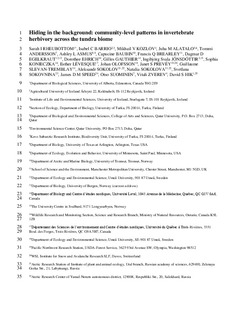| dc.contributor.author | Rheubottom, Sarah I. | |
| dc.contributor.author | Barrio, Isabel C. | |
| dc.contributor.author | Kozlov, Mikhail V. | |
| dc.contributor.author | Alatalo, Juha M. | |
| dc.contributor.author | Andersson, Tommi | |
| dc.contributor.author | Asmus, Ashley L. | |
| dc.contributor.author | Baubin, Capucine | |
| dc.contributor.author | Brearley, Francis Q. | |
| dc.contributor.author | Egelkraut, Dagmar | |
| dc.contributor.author | Ehrich, Dorothee | |
| dc.contributor.author | Gauthier, Gilles | |
| dc.contributor.author | Jonsdottir, Ingibjørg | |
| dc.contributor.author | Konieczka, Sophia | |
| dc.contributor.author | Lévesque, Esther | |
| dc.contributor.author | Olofsson, Johan | |
| dc.contributor.author | Prevéy, Janet S. | |
| dc.contributor.author | Slevan-Tremblay, Guillaume | |
| dc.contributor.author | Sokolov, Aleksandr | |
| dc.contributor.author | Sokolova, Natalia | |
| dc.contributor.author | Sokovnina, Svetlana | |
| dc.contributor.author | Speed, James David Mervyn | |
| dc.contributor.author | Suominen, Otso | |
| dc.contributor.author | Zverev, Vitali | |
| dc.contributor.author | Hik, David S. | |
| dc.date.accessioned | 2020-02-13T07:52:44Z | |
| dc.date.available | 2020-02-13T07:52:44Z | |
| dc.date.created | 2019-10-04T11:52:11Z | |
| dc.date.issued | 2019 | |
| dc.identifier.citation | Polar Biology. 2019, 42 (10), 1881-1897. | nb_NO |
| dc.identifier.issn | 0722-4060 | |
| dc.identifier.uri | http://hdl.handle.net/11250/2641436 | |
| dc.description.abstract | Invertebrate herbivores depend on external temperature for growth and metabolism. Continued warming in tundra ecosys-tems is proposed to result in increased invertebrate herbivory. However, empirical data about how current levels of inverte-brate herbivory vary across the Arctic is limited and generally restricted to a single host plant or a small group of species, so predicting future change remains challenging. We investigated large-scale patterns of invertebrate herbivory across the tundra biome at the community level and explored how these patterns are related to long-term climatic conditions and year-of-sampling weather, habitat characteristics, and aboveground biomass production. Utilizing a standardized protocol, we collected samples from 92 plots nested within 20 tundra sites during summer 2015. We estimated the community-weighted biomass lost based on the total leaf area consumed by invertebrates for the most common plant species within each plot. Overall, invertebrate herbivory was prevalent at low intensities across the tundra, with estimates averaging 0.94% and rang-ing between 0.02 and 5.69% of plant biomass. Our results suggest that mid-summer temperature influences the intensity of invertebrate herbivory at the community level, consistent with the hypothesis that climate warming should increase plant losses to invertebrates in the tundra. However, most of the observed variation in herbivory was associated with other site level characteristics, indicating that other local ecological factors also play an important role. More details about the local drivers of invertebrate herbivory are necessary to predict the consequences for rapidly changing tundra ecosystems. | nb_NO |
| dc.language.iso | eng | nb_NO |
| dc.publisher | Springer | nb_NO |
| dc.title | Hiding in the background: community-level patterns in invertebrate herbivory across the tundra biome | nb_NO |
| dc.type | Journal article | nb_NO |
| dc.type | Peer reviewed | nb_NO |
| dc.description.version | acceptedVersion | nb_NO |
| dc.source.pagenumber | 1881-1897 | nb_NO |
| dc.source.volume | 42 | nb_NO |
| dc.source.journal | Polar Biology | nb_NO |
| dc.source.issue | 10 | nb_NO |
| dc.identifier.doi | 10.1007/s00300-019-02568-3 | |
| dc.identifier.cristin | 1733898 | |
| dc.relation.project | Norges forskningsråd: 262064 | nb_NO |
| dc.relation.project | Andre: Axa - 15-AXA-PDOC-307 | nb_NO |
| dc.relation.project | Andre: Grant of Russian fund for basic research - 18-05-60261 | nb_NO |
| dc.relation.project | Andre: Academy of Finland - 276671 | nb_NO |
| dc.relation.project | Andre: National Science Foundation - DEB 102683 | nb_NO |
| dc.relation.project | Andre: National Science Foundation - OPP 0908502 | nb_NO |
| dc.relation.project | Andre: RGPNS - 305471 | nb_NO |
| dc.relation.project | Andre: Icelandic Research Fund - 1524-68-051 | nb_NO |
| dc.description.localcode | This is a post-peer-review, pre-copyedit version of an article. Locked until 3.09.2020 due to copyright restrictions. The final authenticated version is available online at: DOI: 10.1007/s00300-019-02568-3 | nb_NO |
| cristin.unitcode | 194,31,10,0 | |
| cristin.unitname | Institutt for naturhistorie | |
| cristin.ispublished | true | |
| cristin.fulltext | postprint | |
| cristin.fulltext | original | |
| cristin.qualitycode | 1 | |
